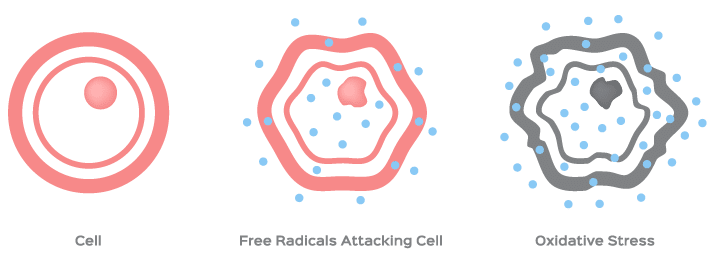Light for a Healthier Life
A Breakthrough in Full Body Photobiomodulation
The Problem with Oxidative Stress

Simply put, oxidative stress is an imbalance between free radicals and antioxidants. Both of these molecules are necessary for normal, healthy reactions in the body, but an excess of either can cause damage.
Free radicals are molecules which contain oxygen and have an uneven number of electrons. Because free radicals have an uneven number of electrons, they’re unstable and highly reactive with other molecules, which helps them cause large chain chemical reactions in the body. On the other hand, antioxidants are molecules that can give up an electron without becoming unstable, so they have the ability to stabilize free radicals.
When there are more free radicals than antioxidants can manage, oxidative stress occurs. Because free radicals are highly reactive, they cause damage to the body’s proteins, fatty tissue, and DNA in their quest for that stabilizing electron. Damage by free radicals can affect cellular function and cause apoptosis, also referred to as programmed cell death.
While our bodies’ cells regularly die and get replaced, published clinical research has indicated prolonged damage by oxidative stress has been linked to a variety of diseases. Oxidative stress also contributes to the aging process and can affect skin’s collagen production and elasticity, causing wrinkles.
Causes of Oxidative Stress
But how does a surplus of free radicals occur? Everyone’s body naturally produces some free radicals, but everybody needs some free radicals in order to be healthy and help fight off infections. An excess of free radicals, and therefore a potential for lasting damage, can be a result of several environmental factors, like pollution, ozone, radiation, certain chemicals and pesticides, and cigarette smoke (including second-hand smoke).
Dietary factors can also play a role in excess free radicals. Diets high in fat, sugar, and alcohol can impact free radical production, and diets containing foods rich in antioxidants, like berries and dark, leafy greens, can introduce antioxidants to help manage free radicals.
How Red Light Therapy Fights Oxidative Stress
While altering our diets can help manage free radicals, sometimes there are factors outside of our control influencing reactive oxygen species in our bodies. Pollution, radiation, and even exposure to cigarette smoke can be inescapable depending on a person’s location or situation. One option to aid in the fight against oxidative stress is red and near-infrared light therapy.
Red light, at specific wavelengths, is readily absorbed by chromophores in the mitochondria of the body’s cells, which activates metabolic energy processes. Red and near-infrared wavelengths of light promote ATP production, which boosts energy transport within cells, leading to increased cell proliferation.
What makes red light different from other forms of light is its ability to penetrate deeper into the skin. While blue and ultraviolet light mainly affects the upper layers of skin, red light can be absorbed by cells deep in the body. Red light therapy is also referred to as photobiomodulation therapy because of the change in the body induced by light, and there are a variety of devices with different capacities of utilizing red light, including red light bed, panels, and targeted deep tissue laser therapy systems.
Photobiomodulation Therapy is Dose-Dependent

The biological effect of Photobiomodulation is dose dependent and based on a number of factors including power level, wavelength, light coherence, operation mode, beam type and size, dosage, tissue thickness, anatomic irradiation site, age, and gender. Whenever light hits tissue it can be transmitted, scatter, reflected, or absorbed depending on the type of tissue and the wavelength of the light. The effectiveness of PBM is closely depended on the level of penetration. If the area needing the light energy cannot be reached, then the outcome will not happen and any level of results may be manifested from the placebo effect that may occur. Light absorption must take place for there to be any biologic effect. A given wavelength of light may be strongly absorbed by one type of tissue and be transmitted or scattered by another. When light is absorbed, it delivers energy to tissue and the tissue’s reaction depends on the intensity (power level) and exposure time (time) of the light, resulting in the total dosage (joules).
For optimal outcomes, using a range of power levels with multiple wavelengths provides a number of advantages over relying solely on a limited power range and a single wavelength. Each wavelength provides a different depth of penetration and tissue saturation. When blended together with multiple wavelengths, it allow beneficial action at the right depth. Studies show that the correct area must be targeted by light at the correct wavelength(s) combined with sufficient power level to achieve a wellness outcome. A single wavelength is limited in its effect it can have on different conditions.
Start Your Journey to Full Body Wellness
Find a TheraLight Full Body Photobiomodulation System near you and feel the difference when you use light for a healthier life.
